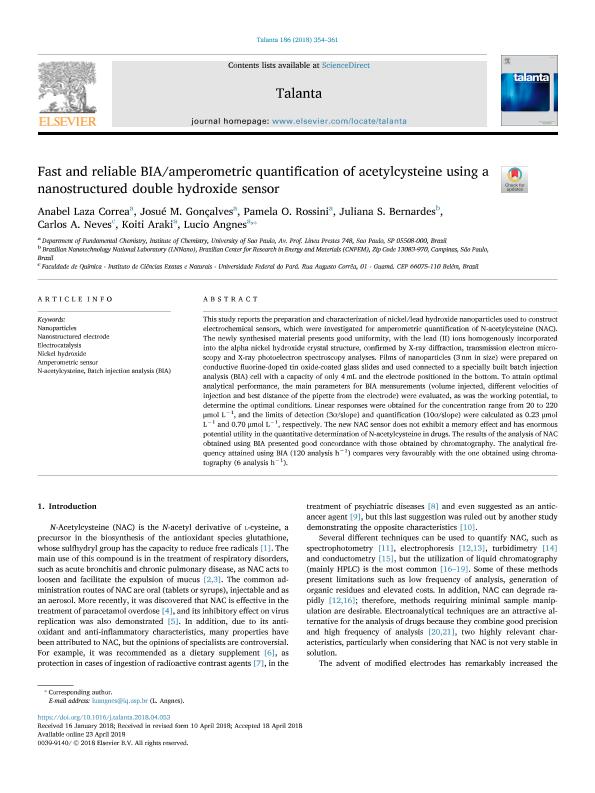Mostrar el registro sencillo del ítem
dc.contributor.author
Laza Correa, Anabel

dc.contributor.author
Gonçalves, Josué M.
dc.contributor.author
Rossini, Pamela O.
dc.contributor.author
Bernardes, Juliana S.
dc.contributor.author
Neves, Carlos A.
dc.contributor.author
Araki, Koiti
dc.contributor.author
Angnes, Lucio
dc.date.available
2020-03-19T18:59:28Z
dc.date.issued
2018-08
dc.identifier.citation
Laza Correa, Anabel; Gonçalves, Josué M.; Rossini, Pamela O.; Bernardes, Juliana S.; Neves, Carlos A.; et al.; Fast and reliable BIA/amperometric quantification of acetylcysteine using a nanostructured double hydroxide sensor; Elsevier Science; Talanta; 186; 8-2018; 354-361
dc.identifier.issn
0039-9140
dc.identifier.uri
http://hdl.handle.net/11336/100336
dc.description.abstract
This study reports the preparation and characterization of nickel/lead hydroxide nanoparticles used to construct electrochemical sensors, which were investigated for amperometric quantification of N-acetylcysteine (NAC). The newly synthesised material presents good uniformity, with the lead (II) ions homogenously incorporated into the alpha nickel hydroxide crystal structure, confirmed by X-ray diffraction, transmission electron microscopy and X-ray photoelectron spectroscopy analyses. Films of nanoparticles (3 nm in size) were prepared on conductive fluorine-doped tin oxide-coated glass slides and used connected to a specially built batch injection analysis (BIA) cell with a capacity of only 4 mL and the electrode positioned in the bottom. To attain optimal analytical performance, the main parameters for BIA measurements (volume injected, different velocities of injection and best distance of the pipette from the electrode) were evaluated, as was the working potential, to determine the optimal conditions. Linear responses were obtained for the concentration range from 20 to 220 μmol L−1, and the limits of detection (3σ/slope) and quantification (10σ/slope) were calculated as 0.23 μmol L−1 and 0.70 μmol L−1, respectively. The new NAC sensor does not exhibit a memory effect and has enormous potential utility in the quantitative determination of N-acetylcysteine in drugs. The results of the analysis of NAC obtained using BIA presented good concordance with those obtained by chromatography. The analytical frequency attained using BIA (120 analysis h−1) compares very favourably with the one obtained using chromatography (6 analysis h−1).
dc.format
application/pdf
dc.language.iso
eng
dc.publisher
Elsevier Science

dc.rights
info:eu-repo/semantics/openAccess
dc.rights.uri
https://creativecommons.org/licenses/by-nc-nd/2.5/ar/
dc.subject
AMPEROMETRIC SENSOR
dc.subject
ELECTROCATALYSIS
dc.subject
N-ACETYLCYSTEINE, BATCH INJECTION ANALYSIS (BIA)
dc.subject
NANOPARTICLES
dc.subject
NANOSTRUCTURED ELECTRODE
dc.subject
NICKEL HYDROXIDE
dc.subject.classification
Química Analítica

dc.subject.classification
Ciencias Químicas

dc.subject.classification
CIENCIAS NATURALES Y EXACTAS

dc.title
Fast and reliable BIA/amperometric quantification of acetylcysteine using a nanostructured double hydroxide sensor
dc.type
info:eu-repo/semantics/article
dc.type
info:ar-repo/semantics/artículo
dc.type
info:eu-repo/semantics/publishedVersion
dc.date.updated
2020-03-19T14:31:13Z
dc.journal.volume
186
dc.journal.pagination
354-361
dc.journal.pais
Países Bajos

dc.journal.ciudad
Amsterdam
dc.description.fil
Fil: Laza Correa, Anabel. Universidade de Sao Paulo; Brasil. Consejo Nacional de Investigaciones Científicas y Técnicas; Argentina
dc.description.fil
Fil: Gonçalves, Josué M.. Universidade de Sao Paulo; Brasil
dc.description.fil
Fil: Rossini, Pamela O.. Universidade de Sao Paulo; Brasil
dc.description.fil
Fil: Bernardes, Juliana S.. Centro Nacional de Pesquisa Em Energia E Materiais; Brasil
dc.description.fil
Fil: Neves, Carlos A.. Universidade Federal do Pará; Brasil
dc.description.fil
Fil: Araki, Koiti. Universidade de Sao Paulo; Brasil
dc.description.fil
Fil: Angnes, Lucio. Universidade de Sao Paulo; Brasil
dc.journal.title
Talanta

dc.relation.alternativeid
info:eu-repo/semantics/altIdentifier/doi/http://dx.doi.org/10.1016/j.talanta.2018.04.053
dc.relation.alternativeid
info:eu-repo/semantics/altIdentifier/url/https://www.sciencedirect.com/science/article/abs/pii/S0039914018304090
Archivos asociados
